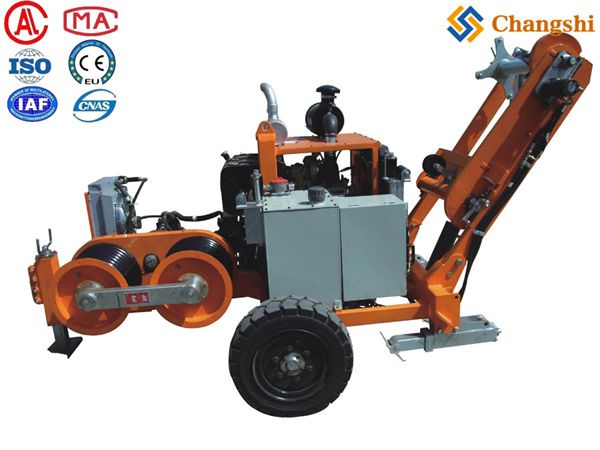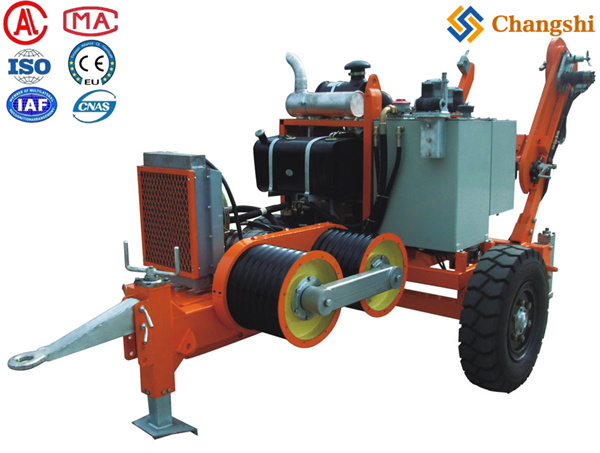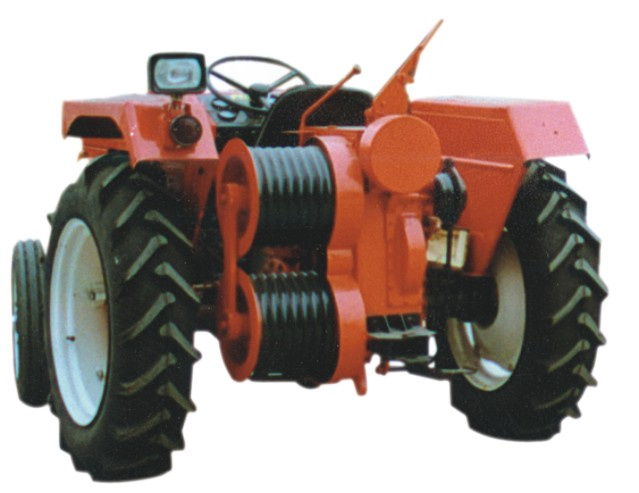
Single Bullwheel Pullers for Transmission
Characteristics of Single Bullwheel Pullers (for single conductor/rope):
Bullwheel Design: These machines feature one set of bullwheels, which are large, grooved wheels (or a pair of parallel wheels) that the pulling rope or conductor wraps around multiple times. The friction generated by these wraps, combined with hydraulic power, provides the pulling force.
Grooves: The bullwheels have grooves lined with wear-resistant materials like MC nylon, neoprene, or polyurethane to protect the conductor from damage during pulling. The number of grooves varies depending on the design and intended application.
Diameter: The diameter of the bullwheels is crucial. Larger diameters reduce the bending stress on the conductor, which is vital for heavy and delicate transmission conductors.
Purpose: Primarily designed for:
Pulling Pilot Ropes: This is a very common application. A strong, lightweight pilot rope (often synthetic or steel wire rope) is first pulled across the span using a single bullwheel puller. This pilot rope is then used to pull the heavier conductor or bundled conductors.
Stringing Single Conductors: For transmission lines that use a single conductor per phase, or for the initial stringing of individual conductors before they are bundled.
OPGW/ADSS Stringing: Optical Ground Wire (OPGW) and All-Dielectric Self-Supporting (ADSS) cables are often strung as single cables, requiring precise tension control from a single bullwheel setup.
Force and Control: Like all hydraulic pullers, they offer:
Infinitely Variable Speed and Pull/Tension Control: Essential for smooth operation and preventing damage to the line.
Automatic Overload Protection: Stops or slows the machine if tension exceeds a preset limit.
Integrated Monitoring Systems: Digital displays for tension, speed, distance, and recording capabilities.
Distinctions for Transmission Applications:
While the term "single bullwheel" might apply to smaller distribution pullers, for transmission lines (especially EHV/UHV), "single bullwheel pullers" refer to machines capable of handling:
Higher Pulling Capacities: Even for a single conductor or pilot rope, the forces required for long spans and heavy transmission line components are substantial. Single bullwheel pullers for transmission can have capacities ranging from 30 kN (3 tons) up to 100 kN (10 tons) or more, depending on the specific model and the application (e.g., pilot rope vs. heavy conductor).
Larger Bullwheel Diameters: As mentioned, larger diameters (e.g., 1500 mm / 59 inches, or larger) are used to minimize bending stress on large transmission conductors.
Robust Construction: Designed for continuous heavy-duty operation in challenging environments.
Advanced Features: Often include sophisticated controls, remote operation, and data logging capabilities to ensure precision and safety during critical transmission line stringing operations.
When are "Single Bullwheel" units used versus "Multi-Bullwheel" or "Bundled Conductor" Pullers?
Single Bullwheel Pullers are ideal for:
Pilot Rope Pulling: This is their most frequent and crucial role in transmission line stringing, as a pilot rope is always pulled first.
Single Conductor Stringing: For lines that don't use bundled conductors.
OPGW/ADSS Stringing: Where a single, sensitive cable is being installed.
Multi-Bullwheel or Bundled Conductor Pullers are used for:
When multiple conductors (e.g., 2, 3, 4, or more) need to be pulled simultaneously as a bundle to save time and reduce operations. These machines typically feature multiple sets of bullwheels (e.g., a "two-bundle" puller would have two separate sets of bullwheels, each handling a conductor, but operating in sync) or very wide bullwheels with multiple grooves precisely spaced for bundles.




